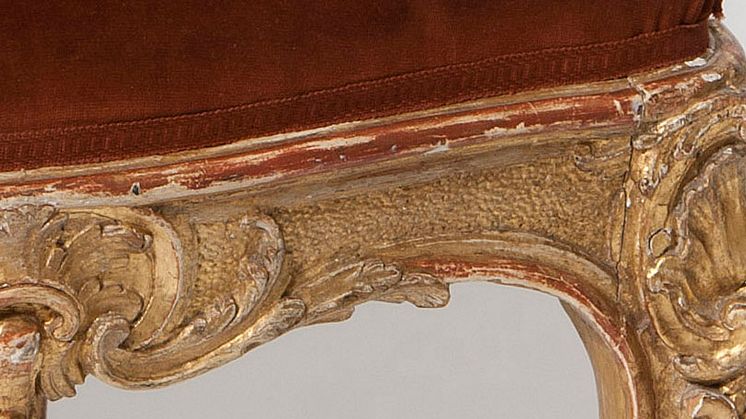
Press release -
New acquisition: 1754 royal dining chair
Nationalmuseum has acquired a royal dining chair dating from 1754. The chair was made for the dining room of the Royal Palace in Stockholm at the time the royal family first took up residence there. The decoration on the back indicates that it was intended for one of the royal children.
Nationalmuseum has added a piece of furniture with royal provenance to its collection. The chair was made in 1754 when the royal family moved into the Royal Palace in Stockholm. For this occasion, every effort was made to create a modern, representative environment. The palace was furnished mainly with Swedish furniture made by Stockholm’s leading craftsmen of the time.
The chair acquired by Nationalmuseum was made for the royal dining room, known as the Pillar Hall. It was intended for use by one of the royal princes, the future kings Gustav III and Charles XIII and their younger brother Fredrik Adolf. In the strict hierarchy of the royal court, the design of a chair was not something left to chance. King Adolf Fredrik and Queen Lovisa Ulrika were seated in gilded armchairs featuring the finest carving. Their children sat on gilded dining chairs without arms and with similar carving. Other guests permitted to sit were assigned one of the 24 yellow-painted dining chairs, with simpler carving, that furnished the rest of the room. Emphasizing the position of the royal children in the hierarchy, their chair backs also featured carved ornamentation. This was not something that people would normally spend money on, since the fashion in the 18th century was to place chairs along the walls of the room.
According to surviving account books, the chair frame was most likely made by Lorentz Nordin, while the decoration was carved by one of the many French and Swedish ornamental carvers employed in the palace workshop. The identity of the chair’s designer is unknown, but its form is in keeping with the stylistic ideals of Carl Hårleman, the architect of the palace. Although Hårleman died in 1753, the year before the chair was made, the commissioned pieces produced after his death continued to reflect his tastes.
Nationalmuseum’s purchase of this high-class chair with royal provenance has been made possible by a generous donation from the Barbro Osher Fund. Nationalmuseum has no budget of its own for new acquisitions, but relies on gifting and financial support from private funds and foundations to enhance its collections of fine art and craft.
Further information
Anders Bengtsson, curator applied art and modern design,anders.bengtsson@nationalmuseum.se, +46 8 5195 4385
Hanna Tottmar, press officer, hanna.tottmar@nationalmuseum.se, +46 8 5195 4390
Categories
Nationalmuseum is Sweden’s premier museum of art and design. The collections comprise older paintings, sculpture, drawings and graphic art, and applied art and design up to the present day. The museum building is currently under renovation and scheduled to open again in 2017. In the meantime, the museum will continue its activities through collaborations, touring exhibitions and a temporary venue at the Royal Swedish Academy of Fine Arts, Fredsgatan 12, Stockholm. Nationalmuseum collaborates with Svenska Dagbladet, Fältman & Malmén and Grand Hôtel Stockholm. For more information visit www.nationalmuseum.se.

